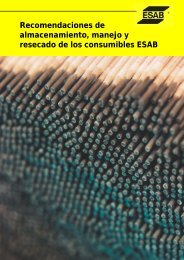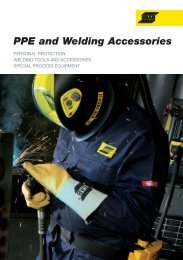Create successful ePaper yourself
Turn your PDF publications into a flip-book with our unique Google optimized e-Paper software.
Figure 4. Another example of an exotic joint. Macro of a PQR. 22mm thick CuAl (UNS C61400) connected to 20 mm duplex stainless steel, welded with semi-automatic TIG with<br />
automatic wire feeding. The duplex material (right) is buffered with two layers of OK Autrod 19.92 (ERNi-1), two layers of OK Autrod 19.93 (ERNiCu-7) and finally with four layers<br />
OK Autrod 19.49 (ERCuNi-7). Subsequently, the two sides are joined with OK Autrod 19.44 (ERCuAl-A2). One layer is welded with MIG, just to get the process approved.<br />
On the duplex side, all buffering layers have been dye-penetrant tested. The first layer of OK Autrod 19.44 (ER CuNi) showed minor indications of cracking. These areas were<br />
ground out and repaired with OK Autrod 19.49 before continuing with OK Autrod 19.44. The arrow shows the repaired area on the macro photo.<br />
science and previous experience. Usually,<br />
corrosion and other material problems are<br />
associated with other system components such<br />
as pumps and valves.<br />
Examples of dissimilar joints<br />
As seen in Table 1, a variety of materials is used<br />
when building a MSF unit and, naturally, many<br />
dissimilar joints have to be welded . Consumables<br />
and welding procedures have to be selected to<br />
ensure both the highest possible mechanical<br />
properties and preservation of excellent corrosion<br />
resistance in salt water, as well as avoiding hot<br />
cracking problems. In addition, it is often<br />
advantageous to have a gradual change in<br />
compositions across a dissimilar weld to distribute<br />
stresses and strains more evenly. Examples of<br />
this approach are shown in procedures presented<br />
in Figures 1, 3 and 4.<br />
The duplex steel (UNS S31803) is lined with 4<br />
mm thick 90/10 copper nickel sheet that is plugwelded<br />
to the duplex material. The plug welds are<br />
made with a very thin layer of OK Autrod 19.92<br />
(ERNi-1), followed by an intermediate layer of OK<br />
Autrod 19.93 (ERNiCu-7) and finally a cap layer<br />
welded with OK Autrod 19.49 (ERCuNi).<br />
In the fillet welds, four different alloy type consumables<br />
are used. As with the plug welds, the<br />
first layer is welded with an ERNi-1 type filler to<br />
minimise the weld metal Fe-content and,<br />
thereby, prevent hot cracking of the following<br />
layers. An alternative approach would have been<br />
to weld the fillet welds with OK Autrod 19.44<br />
(ERCuAl-A2) only. However, the mechanical<br />
properties would not have been on the same<br />
level as with the chosen combination.<br />
Figures 3 and 4 show PQR macros of two other<br />
dissimilar joints and the complicated welding<br />
solutions needed to connect materials that are<br />
not directly compatible from a metallurgical point<br />
of view. These joints could be described as ‘a<br />
welding engineer’s dream’ – but, at the same<br />
time, a nightmare.<br />
The future of desalination in the Middle East<br />
The future for new desalination plants in the Middle<br />
East looks bright due to increasing<br />
development and influx of people. Many countries<br />
investing in tourism require green areas such as<br />
golf links, parks and gardens, all with high daily<br />
water consumption. The general consensus is that<br />
future demand for fresh water can only increase.<br />
ABOUT THE AUTHOR:<br />
JOHAN INGEMANSSON IS PRODUCT MANAGER<br />
CONSUMABLES AT ESAB MIDDLE EAST, DUBAI,<br />
UAE.<br />
26 - <strong>Svetsaren</strong> no. 1 - <strong>2007</strong>




